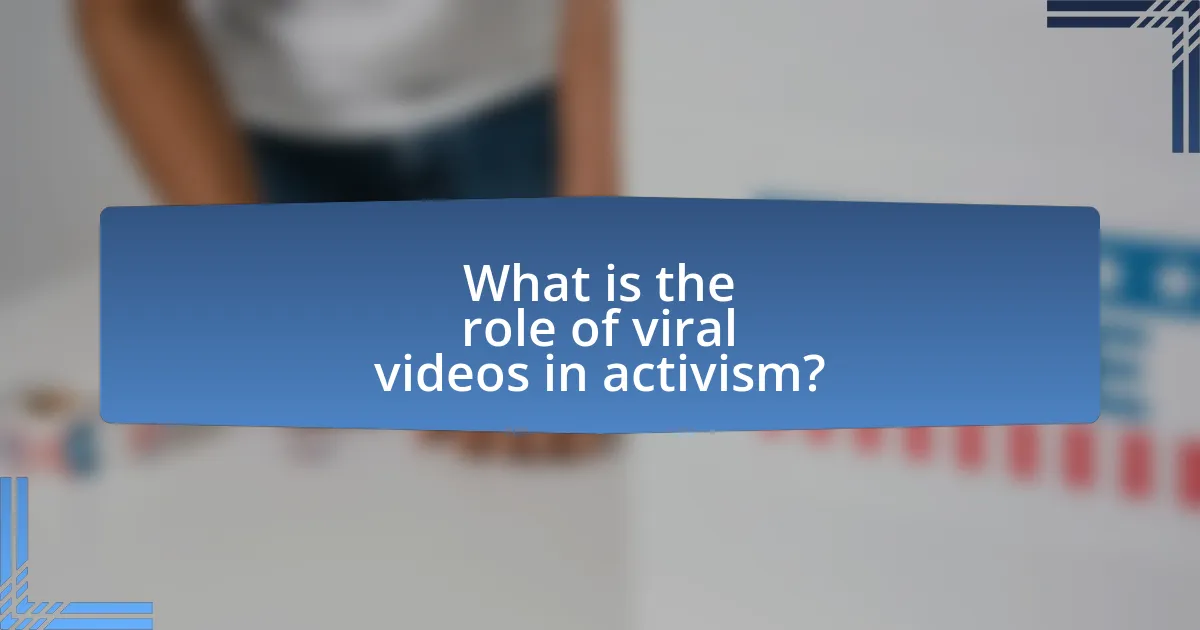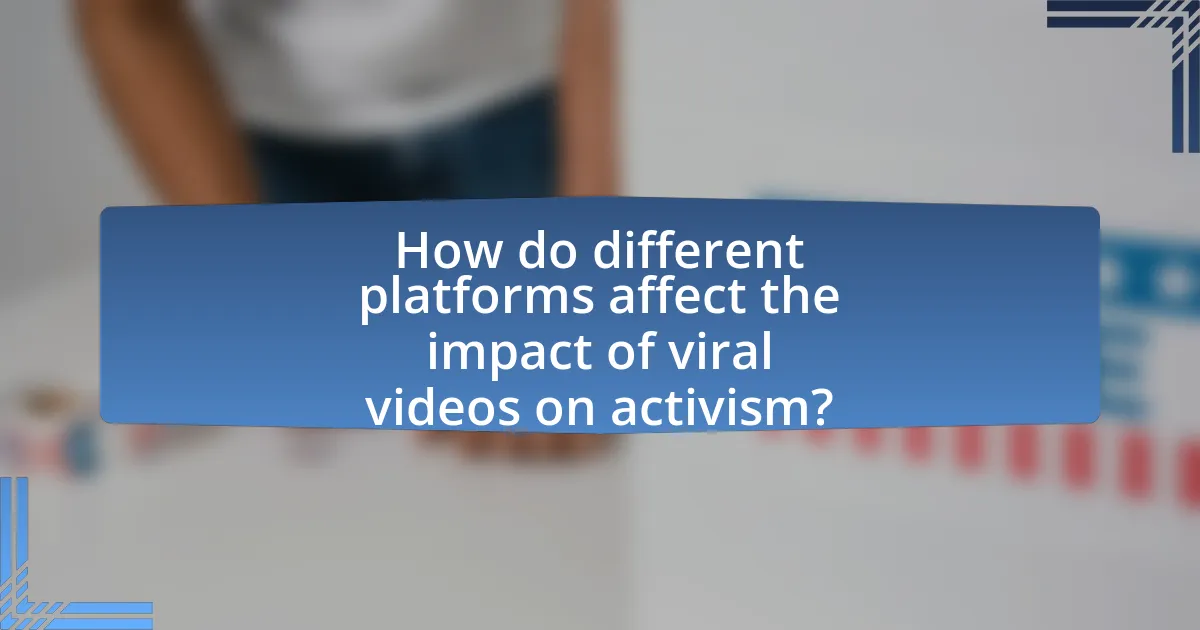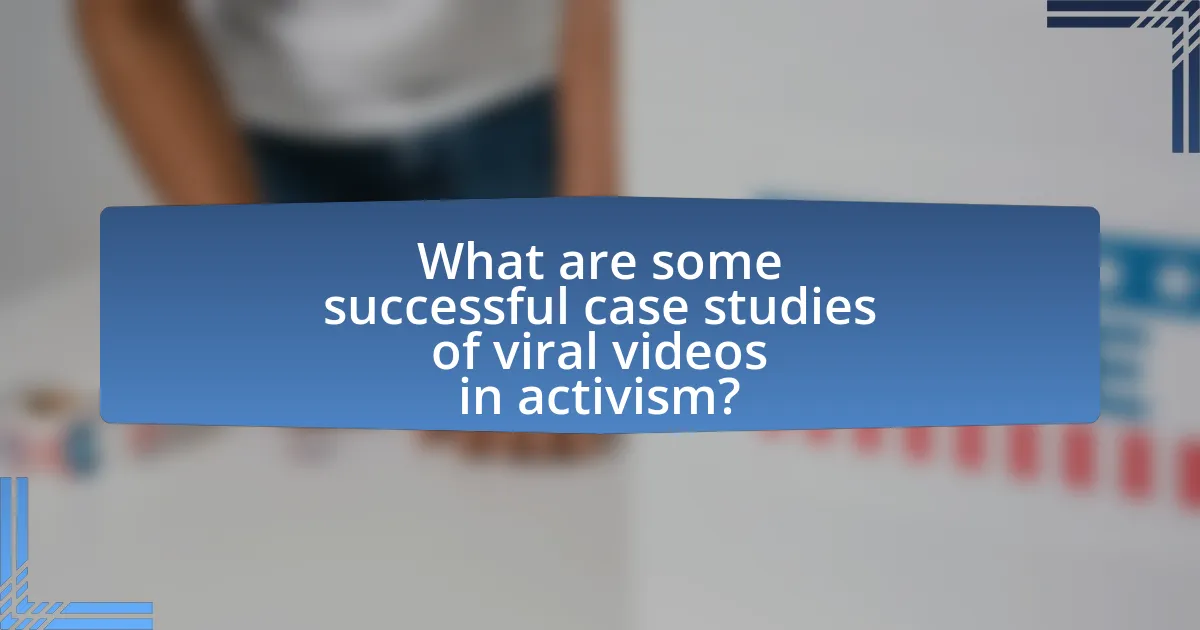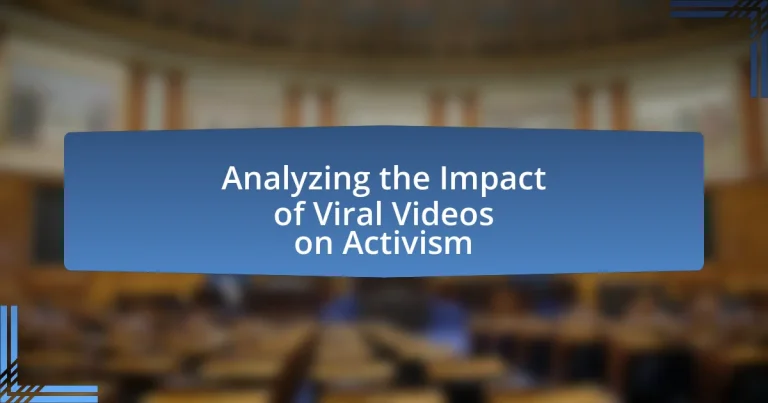The article analyzes the impact of viral videos on activism, highlighting their role in amplifying messages and mobilizing support for social causes. It discusses how viral videos influence public perception of social issues, the psychological factors that contribute to their shareability, and the elements that make them effective tools for activism. Additionally, the article examines the potential drawbacks of viral content, such as oversimplification and misinformation, and explores how different social media platforms affect the dissemination and reception of these videos. Case studies of successful viral campaigns illustrate the strategies employed and the tangible social changes that can result from effective viral activism.

What is the role of viral videos in activism?
Viral videos play a crucial role in activism by amplifying messages and mobilizing support for social causes. These videos often reach a wide audience quickly, leveraging platforms like social media to raise awareness and drive engagement. For instance, the viral video of the Black Lives Matter movement in 2020 significantly increased public discourse around racial injustice, leading to protests and policy discussions globally. Research indicates that visual content is more likely to be shared and retained by viewers, making viral videos an effective tool for activists to communicate their messages and inspire action.
How do viral videos influence public perception of social issues?
Viral videos significantly shape public perception of social issues by rapidly disseminating information and evoking emotional responses. These videos often highlight injustices or urgent matters, making complex issues more relatable and accessible to a broad audience. For instance, the viral video of George Floyd’s death in 2020 catalyzed global protests against police brutality and systemic racism, illustrating how visual content can mobilize public sentiment and action. Research by the Pew Research Center indicates that 64% of Americans believe social media has a major impact on public opinion regarding social issues, underscoring the role of viral videos in influencing perceptions and driving discourse.
What psychological factors contribute to the shareability of viral videos?
Emotional arousal significantly contributes to the shareability of viral videos. Videos that evoke strong emotions, such as joy, surprise, or anger, are more likely to be shared because they create a compelling response in viewers. Research indicates that content that triggers emotional engagement can lead to a 30% increase in sharing behavior. Additionally, social validation plays a crucial role; individuals are motivated to share videos that they believe will enhance their social status or resonate with their social circles. This is supported by findings from a study published in the Journal of Communication, which demonstrated that videos perceived as socially relevant or culturally significant are more likely to be disseminated among peers.
How do viral videos shape narratives around specific causes?
Viral videos shape narratives around specific causes by amplifying emotional engagement and facilitating widespread dissemination of information. These videos often evoke strong feelings, making complex issues more relatable and easier to understand, which can lead to increased public awareness and support. For instance, the viral video of the Ice Bucket Challenge in 2014 raised over $115 million for ALS research, demonstrating how a simple yet engaging concept can mobilize resources and attention towards a cause. Additionally, viral videos can create a sense of community among supporters, as seen with movements like Black Lives Matter, where footage of protests and incidents of injustice has galvanized global support and dialogue. This combination of emotional resonance and community building effectively shapes public narratives and influences perceptions of social issues.
Why are viral videos effective tools for activism?
Viral videos are effective tools for activism because they rapidly disseminate messages to a wide audience, leveraging emotional engagement to inspire action. The visual and auditory elements of videos can evoke strong emotional responses, making complex social issues more relatable and urgent. For instance, the viral video “Kony 2012” reached over 100 million views in just six days, significantly raising awareness about child soldiers in Uganda and prompting global discussions. This demonstrates how viral videos can mobilize support and drive social change by reaching diverse demographics quickly and effectively.
What elements make a video go viral in the context of activism?
Emotional resonance is a key element that makes a video go viral in the context of activism. Videos that evoke strong feelings, such as empathy, anger, or hope, tend to be shared more widely. For instance, the viral video “Kony 2012” effectively used emotional storytelling to raise awareness about child soldiers in Uganda, leading to millions of shares and significant global attention. Additionally, relatability enhances virality; when viewers see themselves in the narrative, they are more likely to engage and share. The use of compelling visuals and clear messaging also plays a crucial role, as seen in the “Ice Bucket Challenge,” which combined humor with a serious cause, resulting in widespread participation and donations for ALS research. These elements—emotional resonance, relatability, and effective visuals—collectively contribute to the viral nature of activism videos.
How do emotions play a role in the effectiveness of viral activism videos?
Emotions significantly enhance the effectiveness of viral activism videos by fostering empathy and motivating viewers to take action. Research indicates that emotionally charged content can lead to increased sharing and engagement; for instance, a study published in the journal “Communication Research” found that videos eliciting strong emotional responses, such as anger or compassion, are more likely to be shared on social media platforms. This emotional resonance not only captures attention but also creates a personal connection to the cause, prompting viewers to advocate for change or support the movement.
What are the potential drawbacks of using viral videos for activism?
The potential drawbacks of using viral videos for activism include oversimplification of complex issues, desensitization of audiences, and the risk of misinformation. Oversimplification occurs when nuanced topics are reduced to brief clips, leading to a lack of understanding among viewers. For example, the viral video of the Black Lives Matter movement may highlight police brutality but fails to address systemic racism comprehensively. Desensitization happens when audiences become numb to repeated exposure to distressing content, diminishing their emotional response and engagement over time. Research indicates that frequent exposure to violent imagery can lead to apathy towards social issues. Lastly, the risk of misinformation arises when videos are edited or taken out of context, potentially spreading false narratives, as seen in various viral clips that misrepresent events or statistics. These drawbacks can undermine the effectiveness of activism by creating misunderstandings and disengagement among the public.
How can misinformation spread through viral videos impact activism?
Misinformation spread through viral videos can significantly undermine activism by distorting public perception and eroding trust in legitimate movements. When false narratives gain traction, they can mislead audiences about the goals, methods, or impacts of activist efforts, leading to confusion and disengagement. For instance, a viral video that inaccurately portrays a protest as violent can deter potential supporters and skew media coverage, ultimately hindering the movement’s effectiveness. Research indicates that misinformation can spread six times faster than accurate information on social media platforms, amplifying its detrimental effects on public discourse and activism.
What are the risks of oversimplification in viral activism content?
Oversimplification in viral activism content risks distorting complex social issues, leading to misunderstandings among audiences. When nuanced topics are reduced to catchy slogans or brief visuals, critical context is often lost, which can result in misinformed public perceptions. For instance, the viral video “Kony 2012” aimed to raise awareness about Joseph Kony but oversimplified the conflict in Uganda, leading to widespread misconceptions about the situation and the complexities of local dynamics. This can foster a superficial understanding that undermines genuine activism efforts and may even perpetuate harmful stereotypes or narratives.

How do different platforms affect the impact of viral videos on activism?
Different platforms significantly influence the impact of viral videos on activism by shaping audience reach, engagement, and message dissemination. For instance, platforms like Twitter and TikTok facilitate rapid sharing and engagement due to their algorithmic structures that promote trending content, allowing activist messages to reach wider audiences quickly. In contrast, Facebook’s algorithm prioritizes content from friends and family, which may limit the exposure of activist videos to a more niche audience. Research indicates that videos on platforms with higher engagement rates, such as TikTok, can lead to increased awareness and mobilization for social causes, as seen in movements like Black Lives Matter, where TikTok played a crucial role in spreading awareness and organizing protests. Thus, the choice of platform directly affects how effectively a viral video can mobilize support for activism.
What role does social media play in the dissemination of viral activism videos?
Social media serves as a crucial platform for the dissemination of viral activism videos by enabling rapid sharing and widespread visibility. The architecture of social media allows users to easily share content with their networks, amplifying the reach of activism messages. For instance, videos that resonate emotionally can achieve millions of views within hours, as seen with the viral video of George Floyd’s death, which sparked global protests and discussions on racial injustice. This rapid spread is facilitated by algorithms that prioritize engaging content, further enhancing the visibility of activism videos. Additionally, social media platforms provide tools for users to engage with content through likes, shares, and comments, fostering community discussions and mobilizing support for causes.
Which platforms are most effective for viral activism and why?
Social media platforms such as Twitter, Facebook, and Instagram are the most effective for viral activism due to their vast user bases and rapid content sharing capabilities. Twitter’s character limit encourages concise messaging, making it ideal for rallying support and spreading awareness quickly. Facebook’s extensive network allows for community building and event organization, facilitating grassroots movements. Instagram’s visual focus enhances engagement through compelling imagery and videos, which can evoke emotional responses and drive shares. According to a study by the Pew Research Center, 69% of adults in the U.S. use Facebook, while 40% use Instagram, highlighting their significant reach for activism. These platforms enable real-time communication and mobilization, making them essential tools for viral activism.
How do algorithms influence the visibility of activism-related content?
Algorithms significantly influence the visibility of activism-related content by determining which posts are prioritized in users’ feeds based on engagement metrics. Social media platforms like Facebook and Instagram utilize algorithms that favor content with higher likes, shares, and comments, thereby amplifying posts that resonate with users, often leading to increased visibility for activism-related messages. For instance, a study by the Pew Research Center found that 64% of Americans believe social media has a significant impact on political activism, highlighting how algorithm-driven visibility can mobilize support for social causes.
How do demographics affect the reception of viral activism videos?
Demographics significantly influence the reception of viral activism videos by shaping viewers’ perspectives, emotional responses, and engagement levels. For instance, age demographics can determine how individuals relate to the content; younger audiences, who are more active on social media, may share and engage with videos more than older demographics. Additionally, cultural background affects interpretation; individuals from marginalized communities may resonate more deeply with videos addressing social justice issues relevant to their experiences. Research indicates that videos featuring relatable narratives or familiar cultural references are more likely to be shared within specific demographic groups, enhancing their viral potential. For example, a study by the Pew Research Center found that 64% of adults aged 18-29 have shared a political video online, compared to only 24% of those aged 50 and older, highlighting the impact of age on engagement with activism content.
What demographic factors influence the sharing and engagement with viral videos?
Demographic factors such as age, gender, education level, and geographic location significantly influence the sharing and engagement with viral videos. Research indicates that younger audiences, particularly those aged 18-34, are more likely to share and engage with viral content, as they are more active on social media platforms where such videos are prevalent. Gender differences also play a role; studies show that women tend to share emotional or socially relevant content more than men. Additionally, individuals with higher education levels are more likely to engage with content that aligns with their interests and values, leading to increased sharing. Geographic location affects access to technology and social media usage patterns, which in turn influences engagement levels. For instance, urban populations typically have higher engagement rates due to better internet access and social media penetration.
How does cultural context shape the interpretation of viral activism content?
Cultural context significantly shapes the interpretation of viral activism content by influencing the values, beliefs, and social norms that viewers bring to the material. For instance, a viral video addressing climate change may resonate differently in a country facing severe environmental issues compared to one where such concerns are less immediate. Research indicates that cultural factors, such as collective identity and historical experiences, affect how audiences perceive and engage with activism. A study by the Pew Research Center found that individuals from collectivist cultures are more likely to respond positively to activism that emphasizes community and shared responsibility, while those from individualistic cultures may focus on personal agency and rights. This demonstrates that cultural context not only frames the message but also determines the emotional and cognitive responses of the audience, ultimately influencing the effectiveness of the activism.

What are some successful case studies of viral videos in activism?
Successful case studies of viral videos in activism include the “Kony 2012” campaign, which aimed to raise awareness about Joseph Kony and the Lord’s Resistance Army in Uganda. The video garnered over 100 million views within a week, significantly increasing global awareness and prompting discussions about child soldiers and humanitarian intervention. Another notable example is the “Ice Bucket Challenge,” which raised awareness and funds for ALS research, generating over $115 million in donations in just a few months. The challenge went viral through social media, engaging millions and highlighting the importance of ALS awareness. Additionally, the “Black Lives Matter” movement utilized viral videos, such as footage of police brutality, to mobilize protests and discussions on systemic racism, leading to significant social and political changes. These case studies demonstrate the power of viral videos in amplifying activist messages and driving social change.
What lessons can be learned from notable viral activism campaigns?
Notable viral activism campaigns demonstrate the power of emotional resonance, strategic timing, and social media engagement in driving social change. Campaigns like the Ice Bucket Challenge raised over $115 million for ALS research by leveraging humor and community participation, illustrating that relatable and engaging content can mobilize widespread support. Additionally, the #MeToo movement showcased the importance of solidarity and shared experiences, leading to significant cultural conversations about sexual harassment and assault. These examples highlight that effective viral activism often combines compelling narratives with a clear call to action, maximizing reach and impact through social networks.
How did specific viral videos lead to tangible social change?
Specific viral videos have led to tangible social change by raising awareness and mobilizing public action around critical issues. For instance, the viral video of George Floyd’s death in 2020 sparked global protests against police brutality and systemic racism, leading to legislative discussions on police reform in various countries. Similarly, the “Kony 2012” video aimed to capture Joseph Kony, resulting in increased public support for international intervention and awareness campaigns. These videos effectively utilized social media platforms to disseminate information rapidly, engage viewers emotionally, and inspire collective action, demonstrating their power to influence societal norms and policies.
What strategies were employed in successful viral activism videos?
Successful viral activism videos employed strategies such as emotional storytelling, clear messaging, and strong visual elements. Emotional storytelling engages viewers by creating a personal connection to the cause, as seen in videos like “Kony 2012,” which effectively used a narrative to raise awareness about child soldiers in Uganda. Clear messaging ensures that the core issue is easily understood, exemplified by the Ice Bucket Challenge, which succinctly communicated the need for ALS awareness and fundraising. Strong visual elements, including impactful imagery and concise editing, enhance viewer retention and shareability, as demonstrated in the “This is Your Brain on Drugs” campaign, which used striking visuals to convey its message. These strategies collectively contribute to the effectiveness of viral activism videos in mobilizing audiences and driving social change.
How can activists effectively create their own viral content?
Activists can effectively create their own viral content by focusing on emotionally resonant storytelling, leveraging social media platforms, and utilizing current trends. Emotional storytelling engages viewers, making them more likely to share content; for instance, videos that evoke strong feelings can increase sharing rates by up to 30%. Social media platforms like TikTok and Instagram have algorithms that favor engaging content, allowing activists to reach wider audiences quickly. Additionally, aligning content with trending topics or challenges can enhance visibility, as seen with the Ice Bucket Challenge, which raised over $115 million for ALS research in a short period. By combining these strategies, activists can maximize the potential for their content to go viral.
What best practices should activists follow when producing viral videos?
Activists should focus on creating emotionally engaging content that resonates with viewers to produce viral videos. This involves using compelling storytelling techniques, high-quality visuals, and clear messaging to capture attention. Research indicates that videos that evoke strong emotions, such as empathy or anger, are more likely to be shared; for instance, a study by the University of Pennsylvania found that emotionally charged content increases sharing rates by up to 30%. Additionally, incorporating a clear call to action encourages viewers to engage further, whether by sharing the video or participating in the cause.
How can activists measure the impact of their viral videos?
Activists can measure the impact of their viral videos through metrics such as view counts, engagement rates, shares, and comments. These metrics provide quantitative data that reflects audience reach and interaction. For instance, a video that garners millions of views and high engagement rates indicates significant interest and potential influence on public opinion. Additionally, tracking changes in social media followers and website traffic after the video’s release can further demonstrate its effectiveness in mobilizing support or raising awareness. Studies show that videos with higher engagement often correlate with increased activism, as seen in campaigns like the Ice Bucket Challenge, which raised over $115 million for ALS research in a short period.


